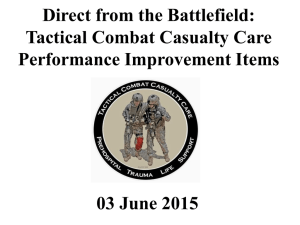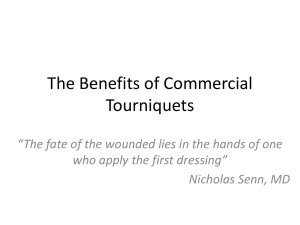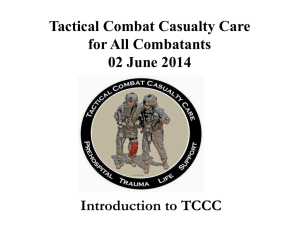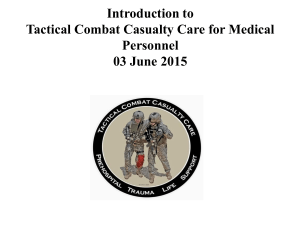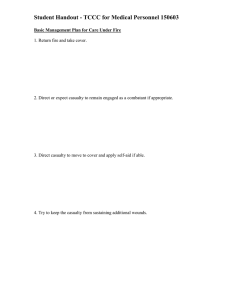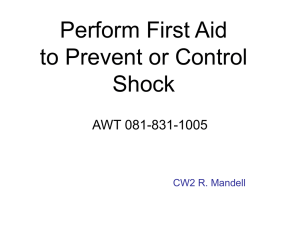Direct from the Battlefield
advertisement
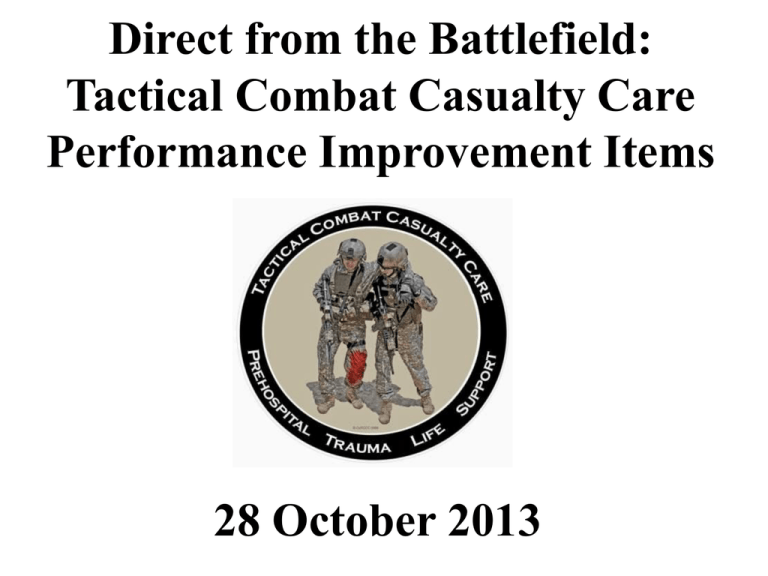
Direct from the Battlefield: Tactical Combat Casualty Care Performance Improvement Items 28 October 2013 TCCC Opportunities to Improve: Sources • Reports from Joint Trauma System (JTS) weekly Trauma Telecons – every Thursday morning – Worldwide telecon to discuss every serious casualty admitted to a Role 3 hospital from that week • Published medical reports • Armed Forces Medical Examiner’s System • Theater AARs • Feedback from doctors, PAs, corpsmen, medics, and PJs The Forgotten Tourniquet The Forgotten Tourniquet • There was a recent adverse outcome from a tourniquet that was left in place for approximately 8 hours. • Be aggressive about putting tourniquets on in Care Under Fire for any life-threatening extremity hemorrhage BUT • Reassess the casualty in Tactical Field Care – remove it if it is not needed unless the casualty is in shock. • Always re-evaluate tourniquets at two hours and remove if possible. Tourniquet Mistakes to Avoid! • Not using a tourniquet when you should • Using a tourniquet for minimal bleeding • Leaving the TQ too high--if placed "high and tight" during care under fire, move to just above the wound during TFC • Not taking it off when indicated during TFC • Taking TQ off when the casualty is in shock or has only a short transport time to the hospital • Not making it tight enough – the tourniquet should both stop the bleeding and eliminate the distal pulse if the distal extremity is intact • Not using a second tourniquet if needed • Waiting too long to put the tourniquet on • Periodically loosening the tourniquet to allow blood flow to the injured extremity • Failing to reassess to make sure the bleeding is still stopped Opioid Analgesics for Casualties in Shock NO Opioid Analgesia for Casualties in Shock • Narcotics (morphine and fentanyl) are CONTRAINDICATED for casualties who are in shock or who are likely to go into shock; these agents may worsen their shock and increase the risk of death • Four casualties in two successive weekly telecons were noted to have received narcotics and were in shock during transport or on admission to the MTFs • Use ketamine for casualties who are in shock or at risk of going into shock but are still having significant pain Untreated Pain on the Battlefield •Slide courtesy of MAJ John Robinson • Data from JTS/JTTS TCCC AARs and PHTR Case Report • • • • • • • • • Male casualty with GSW to thigh Bleeding controlled by tourniquet In shock – alert but hypotensive Severe pain from tourniquet Repeated pleas to PA to remove the tourniquet PA did not want to use opioids because of the shock Perfect candidate for ketamine analgesia Ketamine not fielded at the time with this unit 50 mg ketamine autoinjectors would help - but approval from the FDA is needed to use ketamine in that mode Opioid Analgesics Given in Combination with Benzodiapines Warning: Opioids and Benzos • Ketamine can safely be given after a fentanyl lozenge • Some practitioners use benzodiazepine medications such as midazolam to avoid ketamine side effects BUT • Midazolam may cause respiratory depression, especially when used with opioids • Avoid giving midazolam to casualties who have previously gotten fentanyl lozenges or morphine Penetrating Eye Injuries Penetrating Eye Trauma • Rigid eye shield for obvious or suspected eye wounds - often not being done – SHIELD AND SHIP! • Not doing this may cause permanent loss of vision – use a shield for any injury in or around the eye • Eye shields not always in IFAKs. Can use eye pro instead. • IED + no eye pro + facial wounds = Suspected Eye Injury! Shield after injury No shield after injury Patched Open Globe • Shrapnel in right eye from IED • Had rigid eye shield placed • Reported as both pressure patched and as having a gauze pad placed under the eye shield without pressure • Extruded uveal tissue (intraocular contents) noted at time of operative repair of globe • Do not place gauze on injured eyes! COL Robb Mazzoli: Gauze can adhere to iris tissue and cause further extrusion when removed even if no pressure is applied to eye. • At least two other recent occurrences of patching Antibiotics after Eye Injuries • 2010 casualty with endophthalmitis (blinding infection inside the eye) • Reminder – shield and moxifloxacin in the field for penetrating eye injuries – use combat pill pack! • Also – need to continue moxi both topically and systemically in the MTFs • Many antibiotics do not penetrate well into the eye Tension Pneumothorax The Missed Tension Pneumothorax • A recent U.S. combat fatality was found to have a died with a tension pneumothorax • NO evidence of attempted needle decompression • Monitor anyone with torso trauma or polytrauma for respiratory distress – perform needle decompression when indicated • ALWAYS do bilateral NDC for a casualty with torso trauma who loses vital signs on the battlefield – may be lifesaving Combat Gauze External Hemorrhage – No Combat Gauze • Casualty with gunshot wound in the left infraclavicular area with external hemorrhage • “Progressive deterioration” • External hemorrhage noted to increase as casualty resuscitated in ED • No record of Combat Gauze use • All injuries noted to be extrapleural • Lesson learned: see following slide Combat Gauze™ It doesn’t work if you don’t use it. Junctional Hemorrhage Junctional Hemorrhage • A recent U.S. combat casualty sustained a GSW to the inguinal area • The CASEVAC platform did not have junctional tourniquets aboard • The subsequent junctional hemorrhage was only partially controlled with Combat Gauze • Casualty went into hemorrhagic shock and had to be transfused IED Blast Injury • 3 of 5 casualties had complex blast injuries • All 3 with high traumatic LE amputations and reported difficulty with hemorrhage control despite tourniquet use • Combat Gauze reportedly not used • All 3 would have been excellent candidates for a junctional tourniquet – none were fielded with this unit • All 3 casualties required massive transfusions upon arrival at the Role 2 MTF Junctional Tourniquets Combat Ready Clamp JETT Sam Junctional Tourniquet Junctional tourniquets: They don’t work if your unit doesn’t field them. TCCC Training TCCC Training for ALL combatants: Self and buddy aid should be part of the Warrior Culture in all combat units Eliminating Preventable Death on the Battlefield • Kotwal et al – Archives of Surgery 2011 • All Rangers and docs trained in TCCC • U.S. military preventable deaths: 24% • Ranger preventable death incidence: 3% • Almost a 90% decrease in preventable deaths TCCC in Canadian Forces Savage et al: Can J Surg 2011 Train ALL Combatants in TCCC • Service medical departments responsible for training combat medical personnel only • Line commanders must take the lead to have an effective TCCC training program for all combatants • Ranger First Responder Course is the best model Documentation of TCCC Care TCCC Card – Fill It Out! • You’re not done taking care of your casualty until this is done • USFOR-A FRAGO 13-39 directs the use of the TCCC Casualty Card and electronic AAR • Mission Commanders – this is a leadership issue! New TCCC Card 33 New TCCC AAR 34 Questions? Questions?
